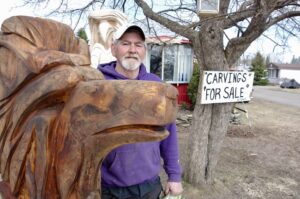Indigenous carver shares Creator’s gift with learners

By Rick Garrick
FORT WILLIAM — Indigenous carver Doug Little used his carving skills to restore two carved wooden statues on Anemki Wajiw (Mt. McKay) over three months during the summer of 2022.
“Last summer, they brought them down and I restored and put them back up there,” says Little, a resident of Fort William First Nation. “From the neck right down to the base, the middle of the [statute] was rotted out so I cut them right out. I put [a new] piece back in and sanded it, finished it, and painted it and they’re saved.”
Little says he began carving when he was 14-years-old but put it aside when he began working until he started again when he was about 19-years-old.
“I got into this because I wanted our youth to keep this alive and to have stuff around so they remember their identities,” Little says. “That’s the gift I was given to do this from our Creator, so why not pass it on and put it out there? And it’s good therapy for me, too.”
Little says he harvests his own logs and carves with a chisel and a blade knife.
“I use the chainsaw to cut the tree but that’s about it,” Little says. “I also do soapstone carving and antlers and I paint and I’m an all-around artist. Before COVID-19, I was travelling to the northern communities and teaching the young ones how to do traditional pipes because I’m also a Pipe Carrier and a pipe maker.”
Little says he usually puts tobacco down in the forest before selecting a tree for carving.
“I envision the piece in it and I bring it home and I do it,” Little says, noting that he likes to use cedar for carving because it is a softer wood. “I see [the image] in the tree before I cut it out. I do eagles but none of them are the same, I’ll try to find a little different way to put it or sentry eagles or with the wings out or the wings down or one wing up and one wing down.”
Little says the first step is to remove the bark and then let the log dry out.
“I’ll look where I’m going to start, I just put my chisel or my knife into it and that’s where I start and I go from there,” Little says, noting that he usually follows the natural shape of the log. “This was a limb sticking out of [the log] and that’s where I made the head. Same as where the wings went [on this other carving], you can see how it’s indented in, too, so that’s how I made the tail feathers and the wings, I followed the tree itself.”
Little says he sands his carved pieces until they are smooth without any burrs before he stains and finishes them.
“I did a century eagle for Eagle Lake and they wanted to put it in the playground but when I took it there, they said: ‘No, we’re going to put that in the library,” Little says.
Little says he carves a variety of different sizes from two feet to 50 feet in length with prices ranging from $300 to $50,000 per piece depending on what the client wants.
“I try to be creative and do things different, not the same,” Little says.
Little says one of his future goals is to make a playground design for children featuring the seven grandfather teachings.
“The Seven (Grandfather) teachings would be in English and [Anishinaabemowin] so they’re learning a little about the language at the same time,” Little says.


